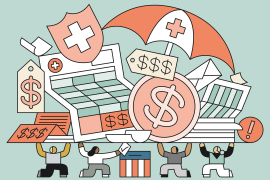While most news stories about Medicaid focus on states’ decisions on whether to expand eligibility, the collective impact of the program on beneficiaries, health providers and systems, and state economies is rarely discussed. Given the large share of federal funds devoted to Medicaid, it’s reasonable to assume that policymakers on both sides of the aisle will be considering programmatic or financing changes for the program—or both—early in a new presidential administration. To inform that process, it’s helpful to look at the multifaceted role Medicaid plays in our health system.
When it was signed into law in 1965 as an extension of welfare, few would have anticipated Medicaid would evolve into the nation’s largest health insurer, covering nearly 73 million Americans.1 Today, Medicaid is at the center of the American health care safety net, providing benefits to adults and children otherwise unable to afford care—and helping to support and drive innovation in the hospitals and clinics that treat these patients, as well as supporting state economies.
Medicaid provides people with good insurance. While the program can vary somewhat by state, a growing body of evidence finds that Medicaid provides a comprehensive set of benefits as well as strong financial protections. A 2015 analysis of the Commonwealth Fund Biennial Health Insurance Survey suggests that people with Medicaid coverage have better access to health care services, including proven preventive care, and fewer medically related financial burdens than those who lack insurance (Exhibit 1). The same study found that Medicaid enrollees have nearly equivalent access to care as those with private coverage in many areas.
In addition, a recent Commonwealth Fund analysis found that patients with complex needs who have Medicaid coverage were less likely to report unmet medical needs than their counterparts with private insurance. This is good news for many older people, given that Medicaid is the primary payer for long-term care for all Americans.
Recent Commonwealth Fund surveys find that majorities of new Medicaid enrollees are satisfied with their health plans (Exhibit 2). There is also emerging evidence that the Affordable Care Act’s Medicaid expansion is helping people get healthy. While a well-publicized Oregon Health Insurance Experiment did not find that gaining Medicaid coverage led to significant improvements in measures of health such as blood pressure, other studies draw clear associations between health coverage and an array of benefits, including improved health status. A multiyear survey found that compared with low-income adults in Texas, which did not expand Medicaid, low-income adults in the expansion states of Arkansas and Kentucky had significant improvements in self-reported health status, as well as reduced use of the emergency department, increased care for chronic conditions, and better quality of care.
Medicaid provides critical support to safety-net health providers and systems. Medicaid makes up a large and growing share of revenue for providers that serve disproportionate numbers of low-income people. Since the ACA coverage expansions took effect in 2014, primary care providers have seen an increase in the share of Medicaid patients they serve and a decrease in uninsured patients. They report that their practices have absorbed these new patients with little negative impact on care.2
In states that have chosen to expand Medicaid, the influx of paying patients has alleviated financial pressure on safety-net hospitals and community health centers. Since 2014, the number of uninsured and self-pay hospital admissions, as well as emergency department visits, has fallen substantially in Medicaid expansion states, reducing uncompensated care costs by $5 billion.3 The resulting savings have enabled safety-net providers to open new clinics, buy new equipment, and hire new staff to help fill gaps in care.4
Medicaid facilitates state-level delivery system reform. Almost every state Medicaid program is working to reform the way health services are paid for and delivered, which can drive improvements throughout state health systems.5 For example, Medicaid was ahead of Medicare and private insurers in testing patient-centered medical homes.6,7 As of 2016, 24 states have a medical home initiative, including 14 multipayer collaborations with private payers and Medicare (Exhibit 3). When served by a medical home, low-income patients are significantly less likely to experience cost-related access problems, such as skipping recommended treatments or not filling prescriptions.8
Medicaid and safety-net providers also have led the way in adopting and using information technology. The Commonwealth Fund’s two national surveys of federally qualified health centers (FQHCs) show that health IT adoption grew substantially among health centers between 2009 and 2013.9 By 2013, FQHCs outpaced office-based physicians in the adoption of electronic health records (EHRs). With EHRs, providers are better able to coordinate care and more likely to provide recommended preventive care to their patients.10
Medicaid brings vital federal resources to states. The billions in federal resources that flow to states through Medicaid represent half of all federal funds to states, and have a profound impact on state and local economies.11 In fiscal 2015, total state spending increased at its fastest rate in more than two decades, thanks largely to federal funding for the Medicaid expansion.12 States that haven’t expanded Medicaid are forgoing billions of dollars in federal funds, even while their residents are contributing to the cost of the expansions in other states, according to a Commonwealth Fund study.
A key part of our health system. Along with providing health insurance to millions of low-income Americans and serving as a critical lever for health system transformation, Medicaid injects significant resources into state economies. The program touches millions of lives every day. From covering more births than any other payer to ensuring that older, vulnerable adults have access to long-term care, Medicaid remains a critical component of our health system.







